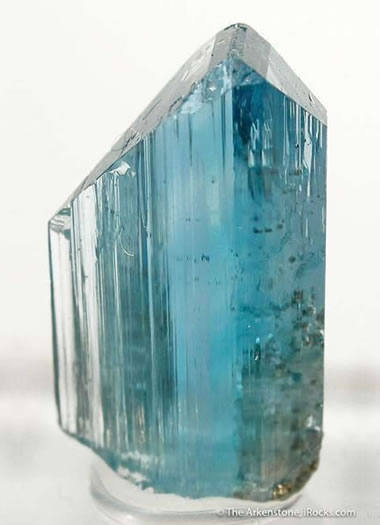Home » Minerals » Euclase
Euclase
A rare beryllium mineral, sometimes cut as a collector's gem

Euclase Crystal: A beautiful blue crystal of euclase with a nice termination and obvious striations. This specimen measures approximately 2.1 x 1.3 x 0.3 centimeters in size and is from Gachala, Boyaca Department, Colombia. Specimen and photo by Arkenstone / www.iRocks.com.
What Is Euclase?
Euclase is a rare beryllium aluminum hydroxide silicate mineral that crystallizes in the monoclinic system. It has a chemical composition of BeAlSiO4(OH). Euclase crystals are usually found in granitic pegmatites and low-temperature hydrothermal deposits. Massive to fibrous euclase is usually found in schists and phyllites.
Rare: Seen by Few Geologists
It is safe to say that most geologists have never knowingly encountered euclase in the field. It is a rare mineral, they are not expecting to see it, it is usually present in small quantities, and because most euclase is colorless to white it is easily overlooked.
Physical Properties of Euclase |
| Chemical Classification |
Beryllium Silicate |
| Color |
Most euclase is colorless or white. However, its color ranges from blue to green to yellowish green. Blue euclase is a favorite of gem and mineral collectors. Rare pink-orange crystals have been found in Brazil. |
| Streak |
White or colorless (when harder than the streak plate) |
| Luster |
Vitreous |
| Diaphaneity |
Transparent to translucent |
| Cleavage |
Perfect cleavage in one direction. Cleavage faces sometimes have a pearly luster. Conchoidal fracture. |
| Mohs Hardness |
7.5 |
| Specific Gravity |
3.0 to 3.1 |
| Diagnostic Properties |
Prismatic crystals with obvious striations, perfect cleavage, color. Colored crystals are usually light in tone and may be pleochroic. |
| Chemical Composition |
BeAlSiO4(OH) |
| Crystal System |
Monoclinic |
| Uses |
No important industrial uses. High-quality crystals are prized by mineral collectors. Specimens with good color and high clarity are faceted as gems for collectors. |
Crystals and Gems for Collectors
Euclase is best known for its prismatic crystals with prominent striations and a beautiful blue color with a light tone. Attractive crystal specimens are prized by mineral collectors. Specimens with excellent blue color and high clarity are often faceted into gems for mineral collectors.
Gem collectors went crazy in 2018 when some padparadscha-like orange-pink euclase was discovered in Brazil. Mineral collectors love the beautiful euhedral crystals of this material, but there wasn't enough to satisfy demand.
Physical Properties
When found in well-developed crystals, euclase can be easy to identify. It often occurs as striated prismatic crystals with chisel-shaped terminations. It also occurs as squat, slightly monoclinic crystals with striations.
Although euclase has a hardness of 7.5, it is a fragile gem. It breaks with perfect cleavage with a pearly luster on the cleavage planes. It is also especially brittle. The name "euclase" is derived from the Greek words eu and klasis, which together mean "good fracture". It is, appropriately, a collector's gem.
Geographic Occurrence
Euclase was first reported from the Orenburg district of Russia's Ural Mountains, where it occurs with other gem materials and gold in stream gravels. The most important source of gem- and specimen-quality euclase today is from Ouro Preto, in the Minas Gerais area of Brazil. Noteworthy euclase occurrences include: Australia, Austria, China, Colombia, Colorado (USA), Germany, Russia, and Zimbabwe.

The best way to learn about minerals is to study with a collection of small specimens that you can handle, examine, and observe their properties. Inexpensive mineral collections are available in the Geology.com Store. Image copyright iStockphoto / Anna Usova.
Rare: Pink-Orange Euclase
The Journal of Gemmology has an interesting article about occurrences of pink-orange euclase hosted in metasedimentary rocks of the Ouricuri do Ouro Formation in central Bahia State of eastern Brazil. These occurrences were discovered in 2015-2016, and a small amount of material entered the gem trade in 2018. The article describes the geology of the area and the gemological properties of the gem-quality euclase in great detail. The article has geologic maps, photos of rough and faceted stones, and results of gemological testing.
An article in Gems & Gemology reports that the padparadscha-like orange-pink color of the euclase is caused by impurities of Mn3+. The article includes a photograph and photomicrographs of a 10.82 carat transparent euhedral crystal displaying a fine silk of acicular crystals.
Sources: Pink-Orange Euclase from Bahia, Brazil, by Laetitia Gilles-Guery and others, The Journal of Gemmology, Volume 38, Number 1, pages 44 to 62, 2022.
Quarterly Crystal: Fibers and Rods in Euclase, by John I. Koivula and others, Gems and Gemology, Volume 57, Number 3, Pages 274 to 275, Fall 2021.
|

Find Other Topics on Geology.com:
 | Rocks: Galleries of igneous, sedimentary and metamorphic rock photos with descriptions. |
|
 | Minerals: Information about ore minerals, gem materials and rock-forming minerals. |
|
 | Volcanoes: Articles about volcanoes, volcanic hazards and eruptions past and present. |
|
 | Gemstones: Colorful images and articles about diamonds and colored stones. |
|
 | General Geology: Articles about geysers, maars, deltas, rifts, salt domes, water, and much more! |
|
 | Geology Store: Hammers, field bags, hand lenses, maps, books, hardness picks, gold pans. |
|

|
 | Diamonds: Learn about the properties of diamond, its many uses, and diamond discoveries.
|
|

 Rare: Seen by Few Geologists
Rare: Seen by Few Geologists Crystals and Gems for Collectors
Crystals and Gems for Collectors Physical Properties
Physical Properties Geographic Occurrence
Geographic Occurrence Rare: Pink-Orange Euclase
Rare: Pink-Orange Euclase

















